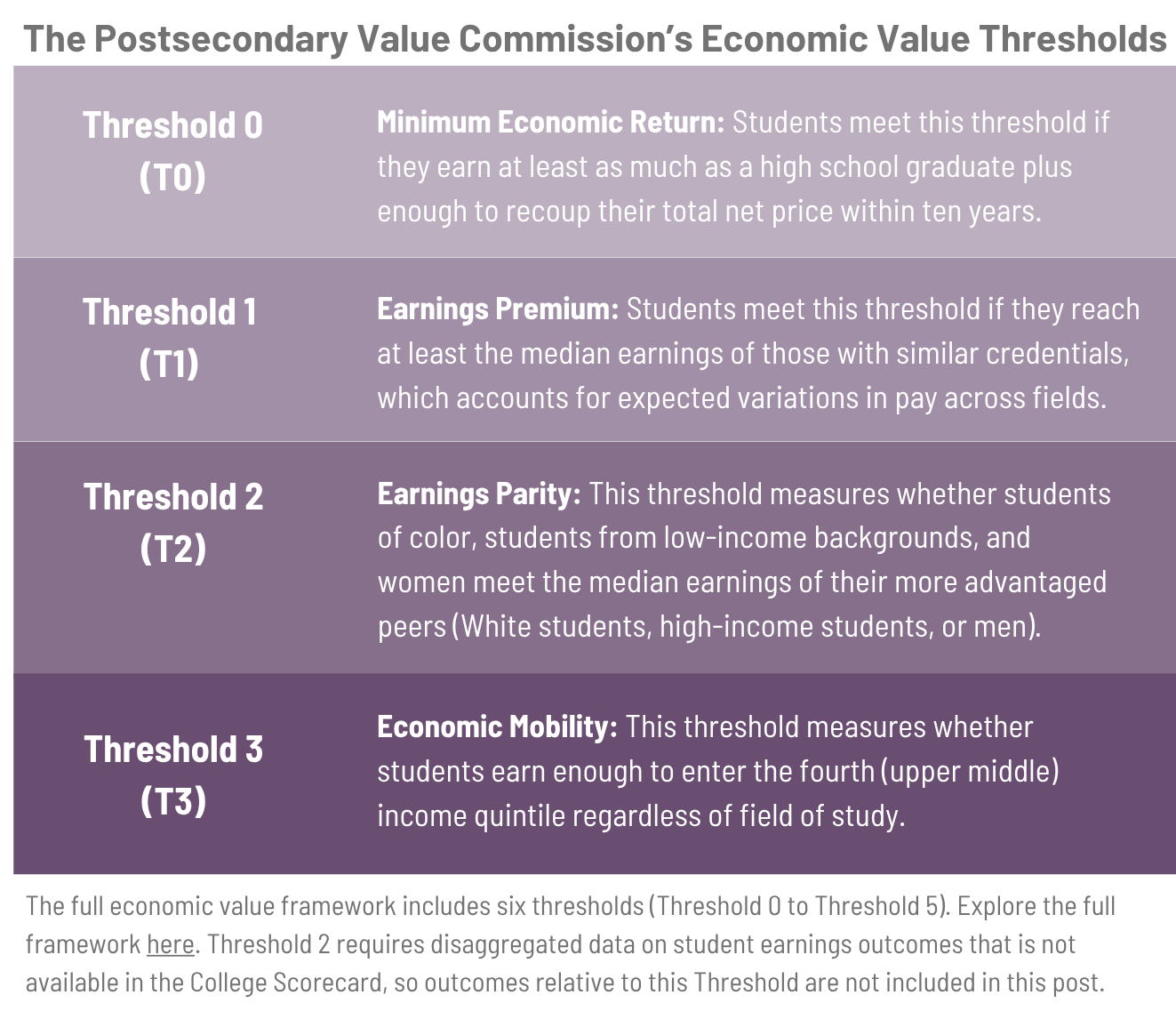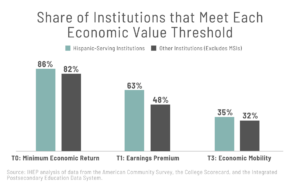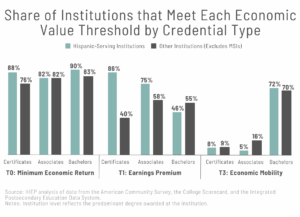Hispanic-Serving Institutions Accelerate Access, Deliver Strong Economic Returns for Students
Published Oct 14, 2025
On September 10, the Trump administration announced it would withhold over $350 million in grants to Minority Serving Institutions (MSIs), including Hispanic-Serving Institutions (HSIs). Education Secretary Linda McMahon stated these cuts were “redirecting financial support away from ineffective and discriminatory programs towards those which support student success.”
Yet HSIs are indeed engines for economic mobility and success. Our latest analysis explores the levels of access and strong economic returns HSIs deliver to students.
More than 30 years ago, the HSI designation was established in federal law to expand institutional capacity to serve Latino students and students with low incomes. Private nonprofit and public institutions with at least 25 percent undergraduate Hispanic enrollment that meet additional criteria, are considered HSIs and can apply for HSI grants. These highly competitive grants fund programs that support student success and workforce development, often at low operational costs.
HSIs are vital entry points to higher education for all students. While these colleges enroll 67 percent of all undergraduate Latino students, they also serve students of all racial, ethnic, and economic backgrounds, according to analysis by the Hispanic Association of Colleges and Universities. The nation’s 615 HSIs enroll one third of all undergraduate students, including 19 percent of White students, 20 percent of American Indian or Alaska Native students, 23 percent of Black students, 31 percent of Native Hawaiian or Pacific Islander students, and 44 percent of Asian American students. HSIs also enroll 37 percent of all Pell Grant recipients, reflecting their central role in supporting students from low-income backgrounds.
Several factors contribute to the racial, ethnic, and economic diversity at HSIs. For example, HSIs often have open admissions policies and welcome anyone with a high school diploma or GED. Additionally, HSIs are primarily located in highly populated and racially and ethnically diverse states and areas. California, Texas, Puerto Rico, New York, Illinois, Florida, New Mexico, and New Jersey are home to 81 percent of HSIs.
Notably, HSIs award the vast majority of associate degrees earned by Latino students and nearly half of bachelor’s degrees earned by Latino students.
Given the proportion of all undergraduates served by HSIs, funding and resource levels for these colleges can have ripple effects on educational opportunities for students across racial and economic lines.
HSIs Deliver Economic Value at Higher Rates than Other Institutions
Many students pursue college to unlock the lifetime of economic benefits a degree can provide. To compare how HSIs and other institutions meet benchmarks for economic value, we used IHEP’s Equitable Value Explorer, an interactive, web-based data tool that illustrates post-college earnings across more than 4,000 colleges and universities.
The Equitable Value Explorer uses economic value thresholds to measure the return on investment students receive after attending college. We found that HSIs meet or exceed all thresholds at similar or higher rates than other institutions, excluding other MSIs.
 For example, Threshold 0 measures whether students’ post-college earnings meet or exceed that of the typical high school graduate, after accounting for the amount they spent on their education. Among HSIs, 86 percent of institutions meet this benchmark, slightly higher than the 82 percent for other institutions. Threshold 1 measures whether former students’ earnings are at least as high as those with similar credentials. Nearly two thirds of HSIs meet this threshold, compared to less than half of other institutions. Finally, Threshold 3 measures whether students’ earnings are at or above the 60th percentile of all working adults. Just over a third of HSIs and just under a third of other institutions meet this threshold.
For example, Threshold 0 measures whether students’ post-college earnings meet or exceed that of the typical high school graduate, after accounting for the amount they spent on their education. Among HSIs, 86 percent of institutions meet this benchmark, slightly higher than the 82 percent for other institutions. Threshold 1 measures whether former students’ earnings are at least as high as those with similar credentials. Nearly two thirds of HSIs meet this threshold, compared to less than half of other institutions. Finally, Threshold 3 measures whether students’ earnings are at or above the 60th percentile of all working adults. Just over a third of HSIs and just under a third of other institutions meet this threshold.
And HSIs meet these benchmarks while serving diverse groups of students, many of whom are students of color or from low income backgrounds, and who have historically faced greater barriers to completing college and securing well-paying jobs post-graduation.

In addition, HSIs that focus on different types of degrees generally provide similar or higher rates of economic value compared to other similar institutions, excluding MSIs.

Protecting Hispanic-Serving Institutions Supports Economic Value for All Students
HSIs are more than access points for Latino students and students from low-income backgrounds. These institutions frequently provide substantial economic returns for their students and, in turn, fuel local economies and communities. The abrupt and unprecedented cuts to HSI funding have raised concern among lawmakers on both sides of the aisle and endanger the gains HSIs have helped students achieve nationwide.
As Hispanic Heritage Month comes to a close, let’s celebrate and amplify the access and postsecondary value HSIs provide to all students. Supporting and protecting HSIs is essential for advancing the promise of higher education for today’s students and future generations.
Data and Methodology:
Postsecondary Value Thresholds are calculated using the American Communities Survey 2023 5-Year Extract, IPEDS, and the College Scorecard. Data on student earnings are median earnings measured 10 years after students enter an institution, from the College Scorecard. If median earnings are at least as much as the Threshold value, an institution is considered to meet that Threshold. For full details on the calculation of each threshold value, please see the methodology report from the Equitable Value Explorer.
Hispanic-Serving Institution designations indicate HSI eligibility and are from the College Scorecard. Institutions with other Minority-Serving Institution designations are excluded from our comparison groups. Percentage calculations are based on institutions with valid earnings data in the most recent College Scorecard for Threshold 1 and 3; institutions must also have academic-year cost of attendance and financial aid information to be included in our Threshold 0 calculations.


